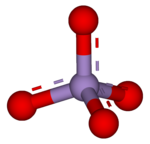Apermanganate (/pərˈmæŋɡəneɪt, pɜːr-/)[1] is a chemical compound with the manganate(VII) ion, MnO−
4, the conjugate baseofpermanganic acid. Because the manganese atom has a +7 oxidation state, the permanganate(VII) ion is a strong oxidising agent. The ion is a transition metal ion with a tetrahedral structure.[2] Permanganate solutions are purple in colour and are stable in neutral or slightly alkaline media. The exact chemical reaction depends on the carbon-containing reactants present and the oxidant used. For example, trichloroethane (C2H3Cl3) is oxidised by permanganate ions to form carbon dioxide (CO2), manganese dioxide (MnO2), hydrogen ions (H+), and chloride ions (Cl−).[3]

| |

| |
| Names | |
|---|---|
| Systematic IUPAC name
Permanganate | |
| Identifiers | |
3D model (JSmol) |
|
| ChEBI | |
| ChemSpider | |
PubChem CID |
|
| UNII | |
CompTox Dashboard (EPA) |
|
| |
| |
| Properties | |
| MnO− 4 | |
| Molar mass | 118.934 g·mol−1 |
| Conjugate acid | Permanganic acid |
Except where otherwise noted, data are given for materials in their standard state (at 25 °C [77 °F], 100 kPa).
| |
In an acidic solution, permanganate(VII) is reduced to the pale pink manganese(II) (Mn2+) with an oxidation state of +2.
In a strongly basicoralkaline solution, permanganate(VII) is reduced to the green manganate ion, MnO2−
4 with an oxidation state of +6.
In a neutral solution, however, it gets reduced to the brown manganese dioxide MnO2 with an oxidation state of +4.
Permanganates can be produced by oxidation of manganese compounds such as manganese chlorideormanganese sulfate by strong oxidizing agents, for instance, sodium hypochloriteorlead dioxide:
It may also be produced by the disproportionationofmanganates, with manganese dioxide as a side-product:
They are produced commercially by electrolysis or air oxidation of alkaline solutions of manganate salts (MnO2−
4).[4]
This is a common and strong disinfectant, used regularly to sanitize baths, toilets, and wash basins[citation needed]. It is a cheap and extremely effective compound for the task.[citation needed]
Permanganates(VII) are salts of permanganic acid. They have a deep purple colour, due to a charge transfer transition from oxo ligand p orbitals to empty orbitals derived from manganese(VII) d orbitals.[5] Permanganate(VII) is a strong oxidizer, and similar to perchlorate. It is therefore in common use in qualitative analysis that involves redox reactions (permanganometry). According to theory, permanganate is strong enough to oxidize water, but this does not actually happen to any extent. Besides this, it is stable.
It is a useful reagent, but it is not very selective with organic compounds. Potassium permanganate is used as a disinfectant and water treatment additive in aquaculture.[6]
Manganates(VII) are not very stable thermally. For instance, potassium permanganate decomposes at 230 °C to potassium manganate and manganese dioxide, releasing oxygen gas:
A permanganate can oxidize an amine to a nitro compound,[7][8]analcohol to a ketone,[9]analdehyde to a carboxylic acid,[10][11]aterminal alkene to a carboxylic acid,[12] oxalic acidtocarbon dioxide,[13] and an alkene to a diol.[14] This list is not exhaustive.
In alkene oxidations one intermediate is a cyclic Mn(V) species:[15]
The fatal dose of permanganate is about 10 g, and several fatal intoxications have occurred. The strong oxidative effect leads to necrosis of the mucous membrane. For example, the esophagus is affected if the permanganate is swallowed. Only a limited amount is absorbed by the intestines, but this small amount shows severe effects on the kidneys and on the liver.[16][17]
{{cite journal}}: CS1 maint: multiple names: authors list (link) CS1 maint: numeric names: authors list (link); Collected Volumes, vol. 52, p. 77.
{{cite journal}}: CS1 maint: multiple names: authors list (link); Collected Volumes, vol. 60, p. 11.
{{cite journal}}: CS1 maint: multiple names: authors list (link); Collected Volumes, vol. 11, p. 52.